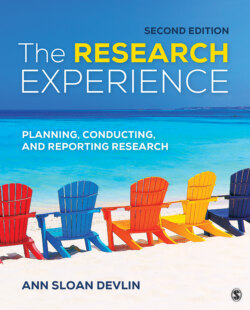Читать книгу The Research Experience - Ann Sloan Devlin - Страница 26
Doing Science as Tradition and Innovation
ОглавлениеWhen we think about how science advances, we can talk about the social and behavioral sciences broadly as a combination of tradition and innovation. As the work of Kahneman and Tversky (and others cited here) has shown, tradition is easier than innovation. It is much easier to operate within an existing framework and harder to figure out how to head in new directions. Most of the time we hope to master the tradition through a review of the literature, and then we take a small step toward innovation by figuring out how we can advance the discipline with this small step. We have to write a literature review or summary of the work in the field that shows our knowledge of past work; at the same time, we have to propose research that goes beyond the existing literature in some way. We should be able to answer the question, “What’s new here?” If views to everyday nature enhance recovery for surgical patients (Ulrich, 1984), why not see whether substitutes for nature such as representational paintings of nature have beneficial effects such as pain reduction. That use of “manufactured nature” would be a step forward. Researchers have done this work, and such representational paintings of nature do in fact reduce stress (Hathorn & Nanda, 2008; see Figure 1.4).
In your work, the problem of being governed by a paradigm or way of thinking about a research topic directly affects the kinds of research questions you are willing to ask. In an influential book written in 1962 titled The Structure of Scientific Revolutions, Thomas Kuhn describes how normal science proceeds. While he concentrates on scientific revolutions in physics, astronomy, and chemistry (e.g., Aristotle and Galileo, Ptolemy and Copernicus, Lavoisier and Priestley), the basic messages he provides in this book about how knowledge accumulates can be applied to the social and behavioral sciences. He states that scientists “whose research is based on shared paradigms are committed to the same rules and standards for scientific practice” (p. 11). Kuhn uses the term paradigm in an overarching way to describe scientific practice; components include “law, theory, application and instrumentation together” (p. 10). As he notes “normal-scientific research is directed to the articulation of those phenomena and theories that the paradigm already supplies” (p. 24) (italics added).
Paradigm: In science, an overarching approach to a field of inquiry that frames the questions to be asked and how research is conducted.
Figure 1.4 Examples of Representational Images of Nature
©Ann Sloan Devlin
In one sense, a theory provides a necessary roadmap for normal science to proceed; on the other hand, we should remember Shermer’s first problem in scientific thinking that theory influences observations and his second that the observer changes the observed. Kuhn references a well-known early study by psychologists Bruner and Postman (1949) in which anomalous (e.g., a red six of spades) as well as normal playing cards are used. A few participants in the study fail to identify the anomalies, even with extended exposure to the these mis-fit cards. In these cases, their experience appears to limit their ability to perceive. Kuhn comments, “In science, as in the playing card experiment, novelty emerges only with difficulty, manifested by resistance against a background provided by expectation” (p. 64).
A major point of Kuhn’s book is that researchers who operate within a paradigm or scientific tradition have a difficult time accepting anomalous data that do not fit within the theories and laws of that framework. When old frameworks or paradigms are overthrown, it is often young researchers who may be outside of that tradition who forge the new framework: these researchers are “so young or so new to the crisis-ridden field that practice has committed them less deeply than most of their contemporaries to the world view and rules determined by the old paradigm” (p. 143). Similarly, as Murray Sidman (1960) states in his volume Tactics of Scientific Research, “sometimes it is the younger scientists, who enter the field unencumbered by the prejudices of past controversies, who pick out the threads of continuity from the tangle of theory, data and pseudo-problems that form a part of every stage of scientific progress” (p. 41).
Though not always resulting in the overthrow of a paradigm, some of the major changes in science have come from young researchers who perhaps were not fully wedded to a single theory or methodology (that hypothesis itself might be testable). Consider the experimental study of memory, where questions of capacity and duration have been studied since at least the time of Ebbinghaus in the late 19th century. As but one example of breaking out of a procedural paradigm, George Sperling’s (1960) doctoral thesis at Harvard University transformed the way scientists think about the storage capacity of very short-term visual memory (immediate memory) by introducing the partial report technique. Prior to that time, using the whole report technique, participants in research on immediate visual memory storage had to call out or recall everything that they had just seen in a brief exposure (~ 50-msec.) to visual stimuli. Sperling’s breakthrough was to have participants call out information presented on only one row in the visual array of three rows (Figure 1.5).
Figure 1.5 Example of Sperling’s (1960) Partial Report Technique
Source: Adapted from Sperling, 1960, p. 3.
Sperling (1960) argued that to recall the information successfully from this one row, participants must have had ALL of the rows available at the time the particular row in question was cued. The cue was presented through an auditory tone (high, medium, or low) to correspond to the position of the rows of information on the page (top, middle, bottom). This approach is a masterful example of tradition (continuing the study of memory through visual exposure) and innovation (changing what was asked of the participant, which in turn dramatically transformed our thinking about the capacity of immediate visual memory).
